Mochi Showdown: Japanese Mochi vs. Korean Mochi (Tteok) - A Cultural and Culinary Comparison

Welcome to the ultimate clash of Asian rice cakes. Find out the winner in one of the most debated East Asian culinary sagas: Mochi vs. Tteok. Which came first? Which has the most uses and benefits? Discover all of these and more in the rest of this post. Enjoy!
Mochi in Japan and Korea
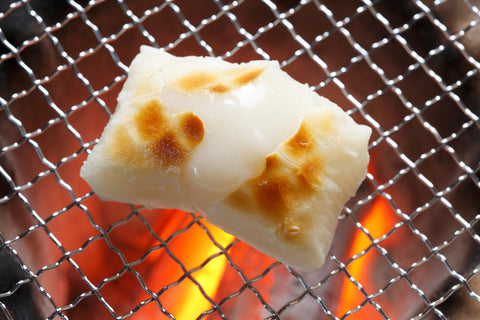
Mochi is a Japanese rice cake made from a type of glutinous rice called mochigome, water, and other ingredients such as sugar and cornstarch. The best parts about eating mochi are the sticky, chewy texture and the sweet taste of the glutinous rice. In Japan, there’s a popular belief that mochi is a “food of the gods” and that it brings good fortune and health. Hence, mochi rice cakes and confectionaries can be found all year at important Japanese celebrations, such as New Year's Day, spring festivals, and Children’s Day. Even the mochi-making process is a cultural event, and it is known as mochitsuki.
The Japanese rice cake is one of Asia’s most versatile dishes, as it takes on many forms, such as daifuku, sakura mochi, and hanabira mochi. Today, mochi variants are used as sweets, ice cream, and even butter!
Mochi has been in Japan since before the 6th century. Also, Japan ruled Korea from 1910 to 1945 so it’s safe to say that Japan had some influence on the country's culture. There has been some speculation that part of that influence may be responsible for the popularity of what many are calling Korean mochi, or tteok. But note that tteok is not a direct copy of mochi. The beloved rice cakes have their differences and similarities, which we will reveal as we progress.
The Origins and Traditions of Japanese Mochi
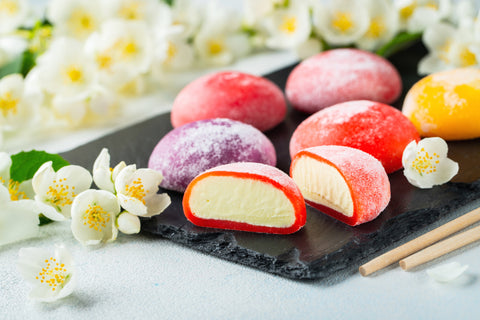
Mochi originated in ancient Japan during the Yayoi period of 300 BCE to 250 CE. Back then, it was associated with the religious ritual of pounding rice to keep evil spirits away from the harvest. Ancient mochi was used as an offering to deities. It was also considered a symbol of good fortune and health.
By the middle of the Kofun period (6th century), mochi had become a popular food in Japanese households. Over the centuries, mochi has been a prominent part of Japanese cuisine, appearing at various traditional festivals and events. During the Japanese New Year or Oshogatsu, families meet and make mochi together using the traditional process. Mochi is also served at the following celebrations: spring, Girl’s Day, and Children’s Day.
Mochi can be eaten plain, filled with other ingredients, or used as dough for Japanese sweets (wagashi). There is a wide variety of Japanese rice cakes, including the following:
-
Sakura mochi
-
Daifuku
-
Mochi ice cream
-
Kagami mochi
-
Dango
Understanding Korean Mochi (Tteok): History and Diversity

We should make it clear that mochi was not the inspiration for tteok. Korean rice cakes have existed since as far back as 500 BCE. They became more popular in the Joseon era of 1392–1897. Boktteok, also called “good fortune rice cake,” is used as a traditional offering to good spirits. It’s also shared among family and friends. During festivities and celebratory events such as the Korean New Year or Chuseok, people make and enjoy tteok. This is similar to the cultural significance of mochi in Japan.
Tteok is one of Asia’s most diverse foods. You can eat it as a plain rice cake or make elaborate meals using ingredients such as nuts, fruits, red beans, or soybeans. Although tteok has hundreds of versions, most of them can be categorized into four types, which are:
-
Steamed tteok: Kongtteok, Baekseolgi, Mujigae tteok, etc.
-
Shaped tteok: Ggul tteok, Ssamtteok, Bupyeon, etc.
-
Pounded tteok: Garae-tteok, Omegi tteok, Injeolmi, etc.
-
Pan-fried tteok: Bukkumi, Hwajeon, Juak, etc.
Japanese Mochi: Ingredients and Preparation
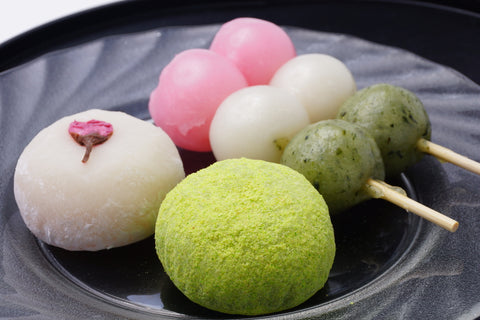
Mochi’s diversity means that there are thousands of potential ingredients used to make the rice cake or dough. However, it has a few primary ingredients worth looking at. Anything else is secondary. The primary ingredients used to make mochi are sweet glutinous rice, water, and sugar. Secondary ingredients include cornstarch, anko (sweet red bean paste), and matcha.
Sweet Glutinous Rice: Mochi’s Signature Ingredient

Seeing as there is no mochi without sweet glutinous rice (mochigome), one could argue that it is the only primary ingredient required to make the cake. This type of rice is responsible for the sweet taste and chewy texture of mochi; hence, regular rice won’t cut it. Traditional mochi preparation involves the pounding of sweet glutinous rice until it forms a sticky dough. These days, you can buy glutinous rice flour and skip the pounding process entirely.
Traditional Mochi Preparation (Mochitsuki)

Only a handful of Japanese households and communities still practice mochitsuki, the ancient traditional style of mochi-making. The process is an elaborate one that could take all day, but it can be summarized into the 4 steps below:
-
The group rinses glutinous rice before soaking it in water and leaving it overnight.
-
They steam the rice in a seiro, wooden steaming basket, by setting it over boiling water.
-
They pound the rice until it turns smooth, shiny, and clear. At least two people are involved in the pounding: one person swings with a wooden mallet and the other turns and wets the rice after each upswing. Great care and concentration are required to maintain the rhythm and avoid injury.
-
The group cuts out pieces of the sticky rice and shapes them into finished mochi.
Korean Mochi (Tteok): Ingredients and Preparation Techniques
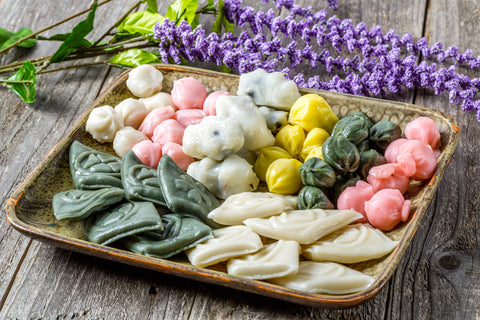
Tteok is just as diverse as mochi, and like the latter, it has some primary ingredients. Korean rice cake or tteok, is made from steamed flour. The flour can come from any type of grain, including glutinous rice. Unlike mochi, which can’t be made with regular rice, tteok can be created with non-glutinous rice. However, tteok also has both traditional and modern preparation methods.
Traditional Mochi Preparation
People in the rural areas of Korea still use traditional methods to make pounded tteok. The procedure is similar to mochitsuki but with a few small differences. Below are the key steps involved:
-
The process starts with the removal of the chaff on glutinous or regular rice (hulling).
-
Rice grains or rice powder are steamed in an earthenware steamer called siru.
-
The rice is pounded with traditional Korean mortar and pestle called jeolgu and gongi, respectively.
-
The pounded rice is removed and coated with other ingredients.
Texture and Taste: Comparing Japanese and Korean Mochi

Both mochi and tteok have similarities and differences in their tastes and textures. Mochi has the taste of sweetened rice but is sticky, chewy, and soft. Its soft and sticky texture is a result of the steaming and pounding of the mochigome. Glutinous rice flour is responsible for mochi’s chewy texture. Most times, mochi is shaped into a round bun.
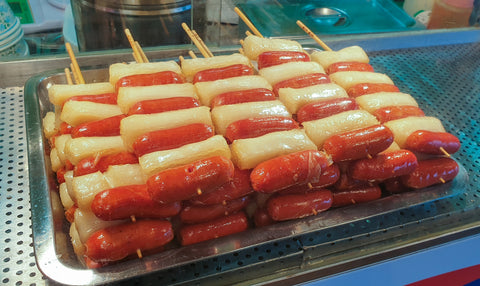
The taste of tteok differs based on the type of grain used to make the steamed flour. The Korean rice cake only has an identical taste to mochi if the flour is made with glutinous rice. Tteok is not as soft as mochi, but it can be just as chewy. It also feels a bit more starchy. Lastly, traditional tteok tends to have a cylindrical or oval shape.
Cultural Significance of Mochi in Japan
As a symbol of good fortune and health, mochi is served on various festive occasions. Let’s explore a few of these events and the types of mochi associated with them.
Japanese New Year
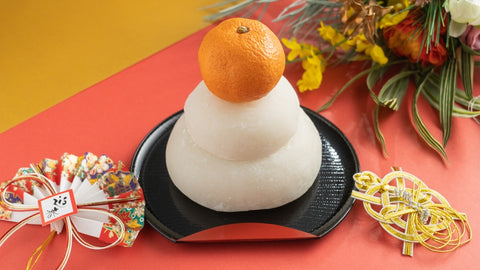
Kagami mochi is used as a spiritual household decoration during the New Year, in a practice called kagami biraki. Two round kagami mochi buns are stacked on top of each other and placed on a religious altar (Shinto or Buddhist). They serve as an offering for the spirits that visit the household in the New Year. On January 11, the now-brittle mochi is broken into pieces, shared, and eaten. Another mochi eaten during the New Year is kinako mochi, which is said to bring good luck.
Spring (Hanami Festival)
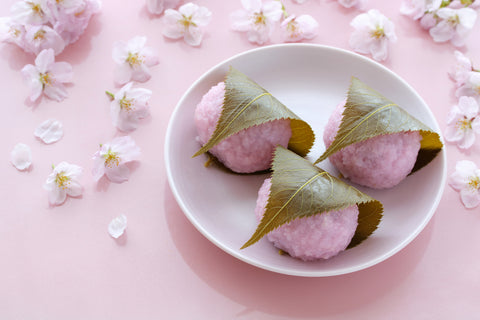
In hanami, or cherry blossom viewing festivals, families and friends gather under sakura trees for a picnic. Sakura mochi is one of the most popular meals eaten at these hanami picnics.
Japanese Children’s Day
In Japan, Children’s Day is celebrated on the 5th of May every year. Both kids and adults enjoy kashiwa mochi as a sweet treat during celebrations.
Girls' Day
A few days before March 3, which is Girl’s Day in Japan, people present hishi mochi as offerings.
The Role of Tteok in Korean Celebrations and Everyday Life
Tteok has symbolism in Korea that is similar to that of mochi in Japan. It’s associated with long life, good fortune, and freedom from evil. Like mochi, tteok also plays a huge role in the festive occasions of its home country.
Jeongwol Daeboreum

Jeongwol Daeboreum, also known as the “Great Full Moon Festival,” is a big part of Korean culture. It involves a lot of eating and sharing of food. One of such foods is a type of tteok called yakbap.
Chuseok

This is Korea’s biggest mid-autumn festival. It’s typically set on day 15 of the 8th month of the lunar year. During this event, it’s not uncommon for people to share delicious songpyeon tteok.
Other Occasions and Everyday Meals
Weddings, funerals, baby birthdays, infant milestones, and housewarmings are all events where you can find different kinds of tteok. Whenever people feel joy or the need to celebrate, tteok is the traditional go-to treat in Korea.
Japanese Mochi in Popular Culture and Modern Snacking
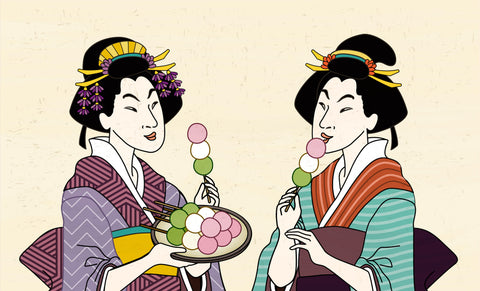
Japanese mochi has crossed borders to become a 21st century global phenomenon. Social media has played a huge role in this, but so has popular culture. Some of Japan’s most beloved anime reference mochi.
One popular instance can be found in Demon Slayer. There is a character in the anime called Mitsuri Kanroji, who has bright pink hair because she ate an insane amount of sakura mochi in her childhood. Another anime, Tamako Market, has a main character called Tamako Kitashirakawa, who is the daughter of a mochi shop owner. A lot of the plot points revolve around mochi.
Mochi also plays a big role in the modern snacking scene. Mochigashi sweets, like daifuku, are filled with sweet fillings (e.g., anko and strawberry) and used as confectionery. Conglomerate businesses all over the world also mass-produce snacks and desserts like mochi ice cream and mochi donuts.
Korean Tteok’s Modern Evolution and Popularity
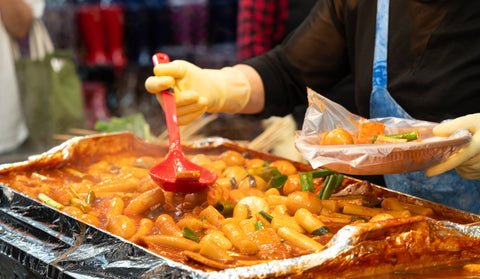
Tteok has become a staple on the streets of Korea. Millions of people every day enjoy tteok-bokki, a tteok dish of rice cakes cooked in a sweet sauce. Small street businesses sell it as frozen meal kits, which people can microwave at home.
On the international front, tteok seems to be doing pretty well. Its portrayal in Korean dramas has also helped to boost its global reputation. However, Korean tteok specialty companies are responsible for scaling up the export of the food to different countries. The United States is one of the largest importers of Korean rice cakes. A big reason for the massive importation is that the dish serves as a healthy snacking option for American lovers of sweet treats thanks to its nutritional value.
Mochi and Tteok: Health Benefits and Nutritional Value
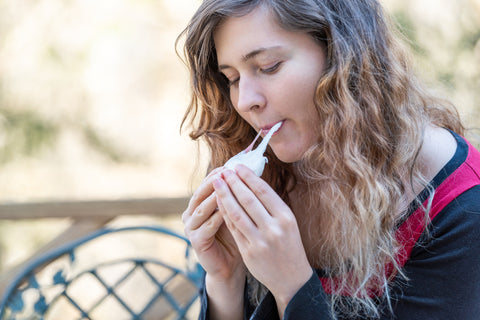
A mochi meal contains a high amount of carbohydrate, moderate protein, and little fat. The high carbohydrate levels contained in the steamed glutinous rice provide lots of energy, making mochi an ideal snack for athletes. The moderate protein levels are enough to aid muscle development and tissue repair. Also, you don’t have to worry about excess weight gain when you eat mochi, thanks to its low-fat composition. Mochi is gluten-free and rich in essential minerals such as iron and calcium, which aid in oxygen transportation and bone development, respectively.
Unlike mochi, which contains low fiber, tteok is high in fiber, making it better at supporting the digestive tract system. Tteok also has a higher protein content and is perfect for anyone working to build muscles. It doesn’t contain too much fat and its traditional version is gluten-free. It’s clear that both Japanese and Korean rice cakes are healthy and nutritious.
Celebrating the Unique Qualities of Japanese Mochi and Korean Tteok

Nutritious, fun, delicious, and traditional. Those are the words that come to mind when we think of mochi and tteok. They are indeed culinary cousins that are only associated with positive wishes like good fortune and long life. We urge you to appreciate and explore the rich traditions behind these iconic foods.
Get practical with Asian treats by subscribing to the Bokksu Snack Box. Every month, we’ll send you dozens of snacks and sweets, including mochi snacks with different flavors. All items come straight from Japan so you can get a taste of the real deal. Our authenticity is guaranteed!
Author Bio











